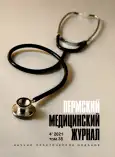Age-related aspects of parasitic morbidity among children in Perm
- Authors: Kochergina E.A.1, Proskurnova Y.N.1, Gushchin M.O.1
-
Affiliations:
- E.A. Vagner Perm State Medical University
- Issue: Vol 38, No 4 (2021)
- Pages: 142-149
- Section: Preventive and social medicine
- URL: https://journals.rcsi.science/PMJ/article/view/95876
- DOI: https://doi.org/10.17816/pmj384142-149
- ID: 95876
Cite item
Full Text
Abstract
Objective. To analyze the dynamics of the incidence of helminthiasis among children, who live in the city of Perm.
Materials and methods. We have retrospectively analyzed the monthly reports of the Center for Hygiene and Epidemiology of the Perm Region for 2015–2020. These reports include the dynamics of the incidence of helminthiasis among four age groups of children: from 1 month to 2 years, 3–6 years, 7–14 and 15–17 years.
Results. Enterobiosis, ascariasis and toxocarosis predominate in the structure of the morbidity in the city of Perm. We found that over the past five years, there has been an increase in the incidence of enterobiosis by 16 %, but the increase in the incidence of ascariasis and toxocarosis reduced – 18 and 25 %, respectively. The rate of decline remains insufficient and the incidence of enterobiosis exceeds the All-Russian one by 2.8 times, ascariasis by 2.7 times and toxocarosis by 4.3 times in comparison with the incidence of parasitic infestations in the Russian Federation. We found that the peak incidence of each nosology falls on the preschool age from 3 to 6 years. Just at this age period, children enter organized groups for the first time, get acquainted with the world through "taste it" and have low sanitary skills.
Conclusions. A routine parasitic screening is effective, since in 2020, more than a half of sick children in Perm were identified during preventive examinations (65.7 %) and only in 34.3 % of cases the diagnosis of parasitic infestation was established on the basis of clinical data.
Keywords
Full Text
##article.viewOnOriginalSite##About the authors
E. A. Kochergina
E.A. Vagner Perm State Medical University
Author for correspondence.
Email: keaperm@mail.ru
Candidate of Medical Sciences, Associate Professor, Department of Pediatrics with Course of Polyclinic Pediatrics
Russian Federation, PermYu. N. Proskurnova
E.A. Vagner Perm State Medical University
Email: keaperm@mail.ru
sixth-year student of Pediatric Faculty
Russian Federation, PermM. O. Gushchin
E.A. Vagner Perm State Medical University
Email: keaperm@mail.ru
sixth-year student of Pediatric Faculty
Russian Federation, PermReferences
- Davydova I.V. Helminthiasis registered on the territory of the Russian Federation: epidemiological situation, features of the biology of parasites, pathogenesis, clinic, diagnosis, etiotropic therapy. Consilium Medicum 2017; 19(8): 32–40 (in Russian).
- Lysenko A.Ya., Vladimova M.G., Kondrashin A.B., Majori J. Clinical parasitology. the manual. Geneva: WHO 2002; 752 (in Russian).
- Jill E. Weatherhead , Peter J. Hotez , Rojelio Mejia. The Global State of Helminth Control and Elimination in Children. Pediatric Clinics of North America 2017; 64(4): 867–877.
- Kei Owada, Mark Nielsen, Colleen L. Lau, Archie C.A. Clements, Laith Yakob, Ricardo J. Soares Magalhães. Measuring the Effect of Soil-Transmitted Helminth Infections on Cognitive Function in Children: Systematic Review and Critical Appraisal of Evidence. Advances in Parasitology 2017; 68: 1–37.
- Blokhin B.M., Prokhorova A.D., Suyundukova A.S., Lobushkova I.P. Actual aspects of diagnosis and treatment of helminthic infestations. Pediatrics 2020; 4: 66 (in Russian).
- On the incidence of geohelminthiasis in the Russian Federation in 2015: a letter from Rospotrebnadzor. Moscow 2016; 01/13265-16-27 (in Russian).
- Teman I., Endalew Z. et al. Epidemiology of soil-transmitted helminths and Schistosoma mansoni: a baseline survery among school children, Ejaji, Ethiopia. The Journal of Infection in Developing Countries 2018; 12(12).
- Andreeva A.O., Golovchenko N.V., Zhuravlev A.S. Toxocarosis in children: epidemiological, clinical and laboratory aspects. Russian Medical Journal 2020; 4 (9) (in Russian).
- Parasites, available at: https://www.cdc.gov/ parasites/pinworm/prevent.html.
- Kristjana H. Asbjörnsdottir, Arianna R. Means, Marleen Werkman, Judd L. Walson. Prospects for elimination of soil-transmitted helminths. Current Opinion in Infectious Diseases 2017; 30 (5): 482–488.
- Naomi E. Clarke, Archie C.A. Clements, Suhail A. Doi, Dongxu Wang, Suzy J. Campbell, Darren Gray, Susana V. Nery. Differential effect of mass deworming and targeted deworming for soil-transmitted helminth control in children: a systematic review and meta-analysis. The Lancet 2017; 21: 287–297.
Supplementary files









